The Magnificent Frigatebird, a majestic seabird renowned for its impressive aerial displays and striking appearance, captivates bird enthusiasts worldwide.
With its long wingspan, distinctive silhouette, and vital red throat pouch (present in males during breeding season), this species exudes elegance and grace as it soars over tropical and subtropical oceans.
Named for resembling old warships, the Magnificent Frigatebird commands attention both in flight and at rest.
Its fascinating life history, marked by unique behaviors such as kleptoparasitism and colonial nesting, makes it a subject of intrigue for researchers and birdwatchers alike. So, stay sharp.
Physical Characteristics of Magnificent Frigatebird
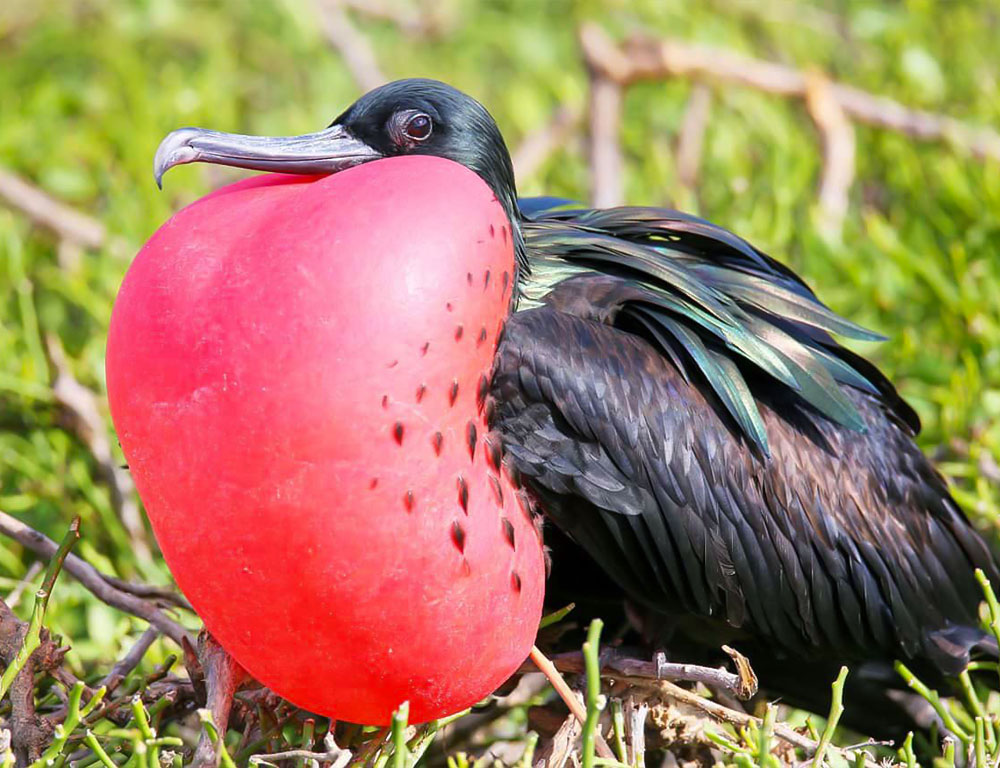
The Magnificent Frigatebird, scientifically known as Fregata magnificent, is a distinctive seabird renowned for its striking appearance and remarkable aerial prowess.
Identifying this species involves observing several key physical characteristics:
Large Size
Magnificent Frigatebirds are sizable birds with a wingspan of up to 7.5 feet (2.3 meters) and a length of around 3 feet (0.9 meters) from beak to tail. Their impressive size makes them stand out among other seabirds.
Long, Forked Tail
One of the most recognizable features of the Magnificent Frigatebird is its long, deeply forked tail. This tail shape is unique among seabirds and aids in their aerial maneuverability.
Black Plumage
Adult male Magnificent Frigatebirds have entirely black plumage, which contrasts sharply with their bright red throat pouch (gular sac) during the breeding season.
In contrast, females and juveniles have a white breast and belly.
Conspicuous Flight Profile
Magnificent Frigatebirds exhibit a distinctive silhouette when in flight with long, pointed wings and a deeply forked tail.
They often soar high in the sky with effortless grace, utilizing thermal currents to remain aloft for long periods without flapping their wings.
Hooked Bill
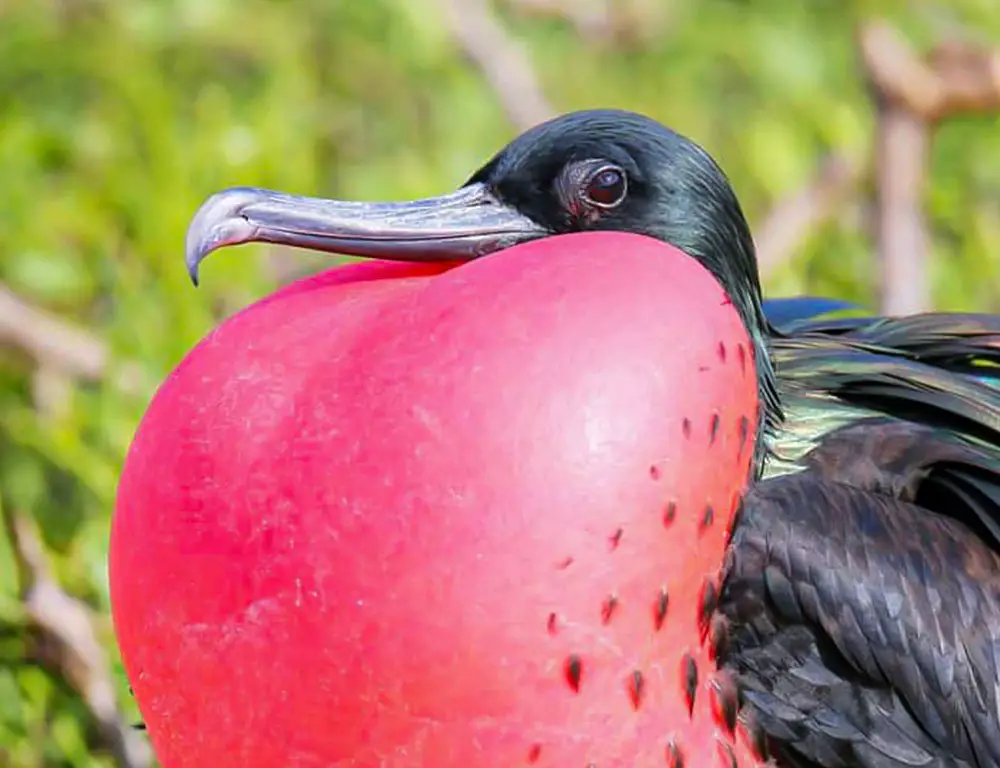
Another notable characteristic is their long, hooked bill, which they use to snatch prey from the water’s surface.
The bill is proportionally large compared to their head and is ideal for catching fish and other marine organisms.
Lack of Waterproofing
Unlike most seabirds, Magnificent Frigatebirds lack waterproof plumage. This trait prevents them from diving into the water to catch prey and necessitates them to snatch food from the surface instead.
Distinctive Flight Behavior
While soaring, Magnificent Frigatebirds often exhibit a unique flight behavior called “kleptoparasitism,” where they harass other seabirds, such as gulls and terns, to steal their food.
This behavior can be observed as they chase other birds in mid-air.
Habitat Preference
Magnificent Frigatebirds are primarily found in tropical and subtropical regions, particularly along coastlines, where they inhabit islands, mangroves, and coastal cliffs.
They commonly roost in large colonies on rocky outcrops or trees near the shore.
Identifying the Magnificent Frigatebird involves recognizing its large size, distinctive silhouette in flight with a forked tail, lack of waterproofing, unique flight behavior, and habitat preference in coastal tropical and subtropical regions.
By paying attention to these critical characteristics, birdwatchers and enthusiasts can easily distinguish this remarkable seabird from other species in its habitat.
Taxonomy of Magnificent Frigatebird
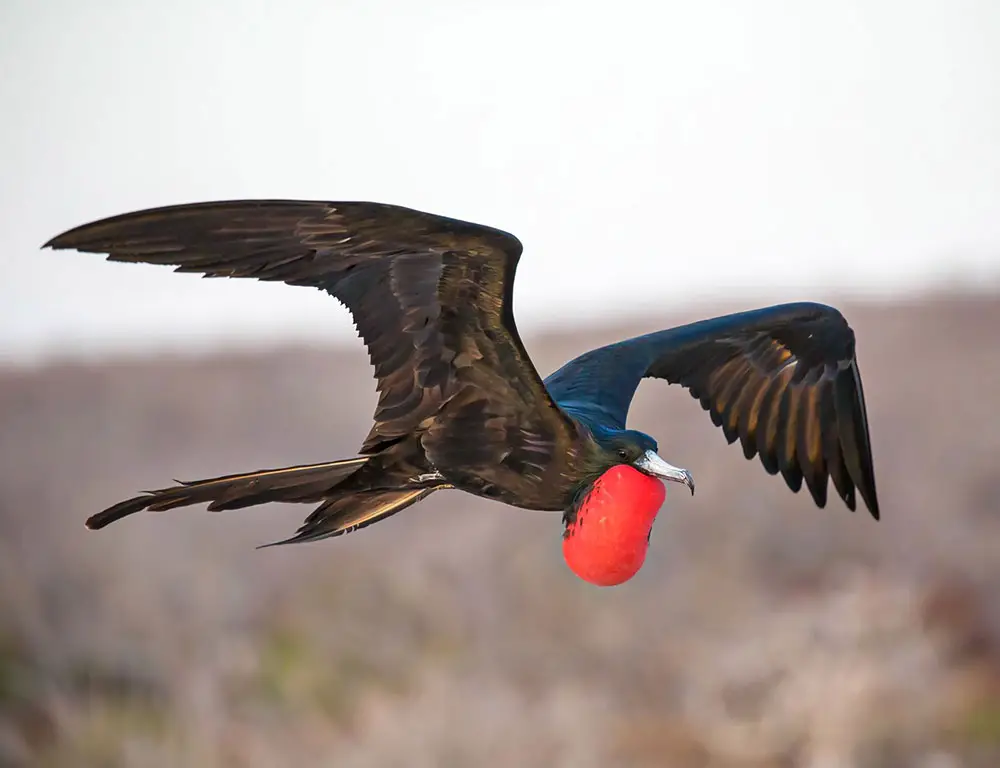
Here’s a lovely table detailing the taxonomy of Frigatebirds:
| Taxonomic Level | Category |
| Domain | Eukaryota |
| Kingdom | Animalia |
| Phylum | Chordata |
| Class | Aves |
| Order | Suliformes |
| Family | Fregatidae |
| Genus | Fregata |
| Species | F. magnificens |
The Magnificent Frigatebird (Fregata magnificens) exhibits two distinct subspecies, each with its unique breeding range and characteristics:
F. m. magnificens
This subspecies is endemic to the Galápagos Islands, where it breeds and nests. Known for its striking appearance and remarkable aerial displays, F. m. magnificens thrives in the unique ecosystem of the Galápagos archipelago.
These birds play a vital role in the island’s marine ecosystem, preying on fish and squid with their sharp bills and engaging in elaborate courtship rituals during the breeding season.
Conservation efforts in the Galápagos aim to protect the habitat of F. m. magnificens and ensure the survival of this iconic species.
F. m. rothschildi
The second subspecies of the Magnificent Frigatebird, F. m. rothschildi, is distributed across a broader range, including islands off the Pacific coast of Mexico and Central America and parts of the tropical Atlantic from Florida south to Brazil.
Additionally, it can be found on the Cape Verde islands, although its population there is greatly diminished. These birds exhibit similar behaviors to their Galápagos counterparts, including kleptoparasitism and colonial nesting.
Conservation efforts for F. m. rothschildi focus on preserving nesting sites, mitigating threats from habitat destruction and human disturbance, and monitoring population trends to ensure long-term survival.
Despite the differences in their breeding ranges, both subspecies of the Magnificent Frigatebird share remarkable adaptability to their oceanic habitats and play essential roles in maintaining the health of marine ecosystems.
Conservation efforts to protect these birds are crucial for preserving biodiversity and ecological balance in their respective regions.
Reproduction of Magnificent Frigatebird
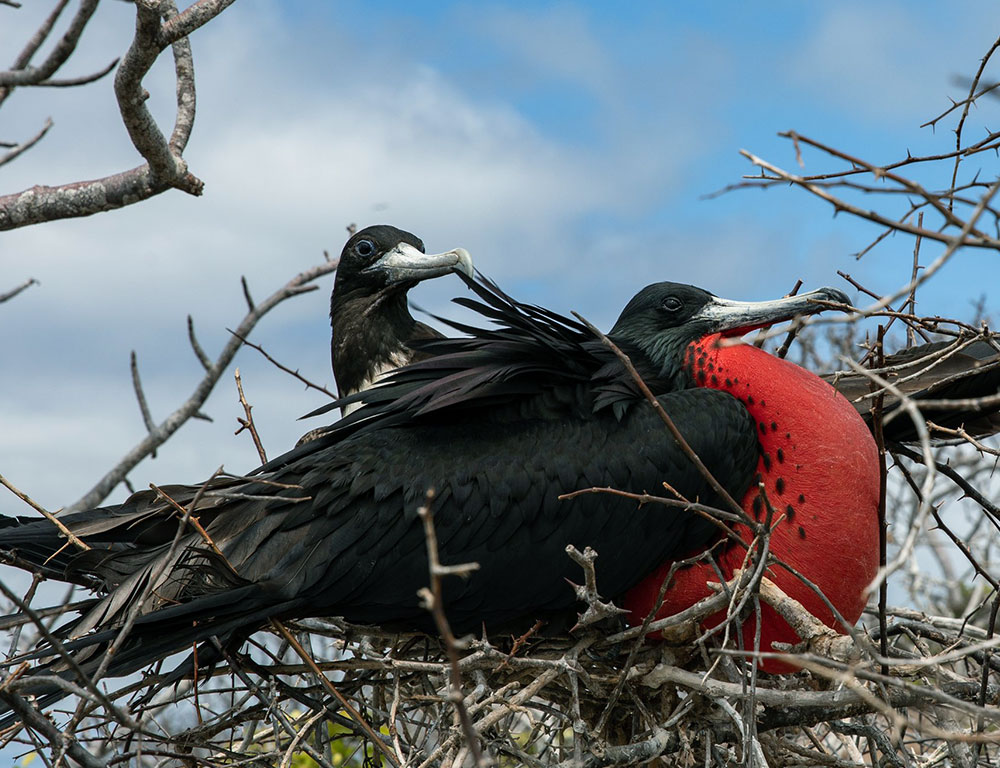
The Magnificent Frigatebird’s reproduction process begins with elaborate male courtship displays, involving inflating their bright red throat pouches to attract females.
Once a mate is selected, the pair builds a nest using twigs and other materials, typically in trees or bushes near the coast.
Female Magnificent Frigatebirds lay a single egg, which both parents take turns incubating for around 50 days.
After hatching, the chick is cared for by both parents, who regurgitate food to feed it. The chick proliferates and reaches fledging age in about 5 months.
Magnificent Frigatebirds typically breed in large colonies, providing some level of protection against predators. Their reproductive cycle is closely tied to environmental factors such as food availability and weather conditions.
Magnificent Frigatebird Life History
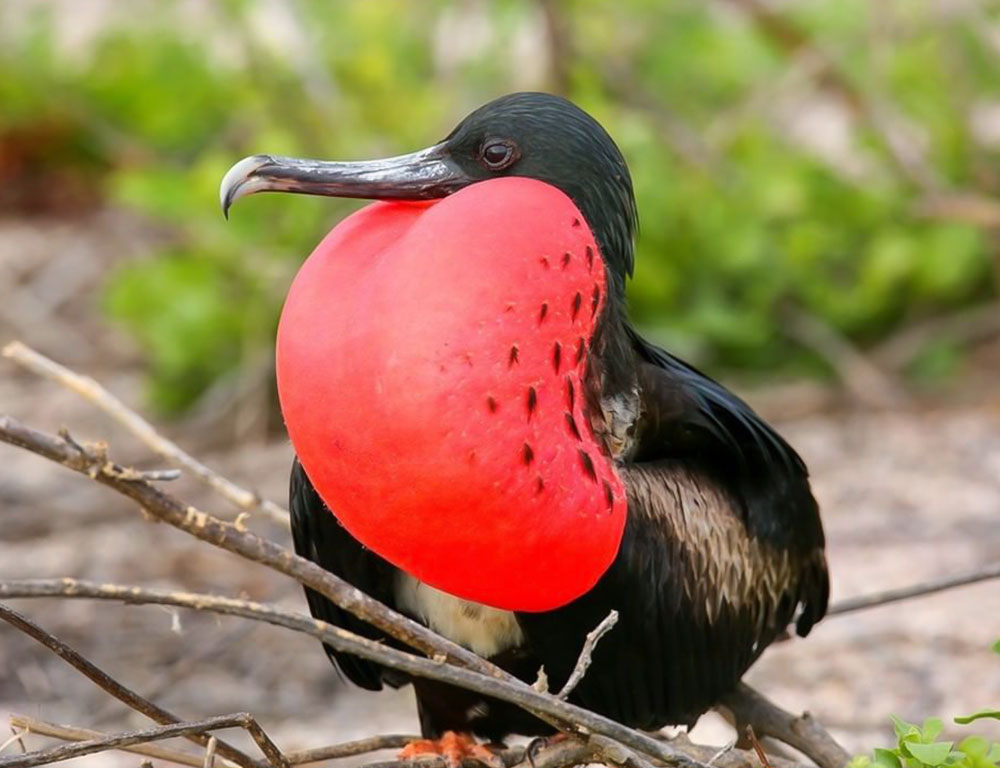
The Magnificent Frigatebird, Fregata magnificent, is a captivating seabird known for its remarkable aerial prowess and striking appearance.
This species is found in tropical and subtropical regions worldwide and boasts a fascinating life history shaped by its unique adaptations and environmental interactions.
Food
Magnificent Frigatebirds feed on fish and squid, which they snatch from the water’s surface using their long, hooked bills.
They are adept at stealing food from other seabirds through a behavior known as kleptoparasitism, where they harass other birds in flight to steal their catch.
Habitat
These birds inhabit coastal regions, including islands, mangroves, and seaside cliffs. They prefer areas with abundant marine life for foraging and suitable nesting sites, often roosting in large colonies for protection.
Range Map
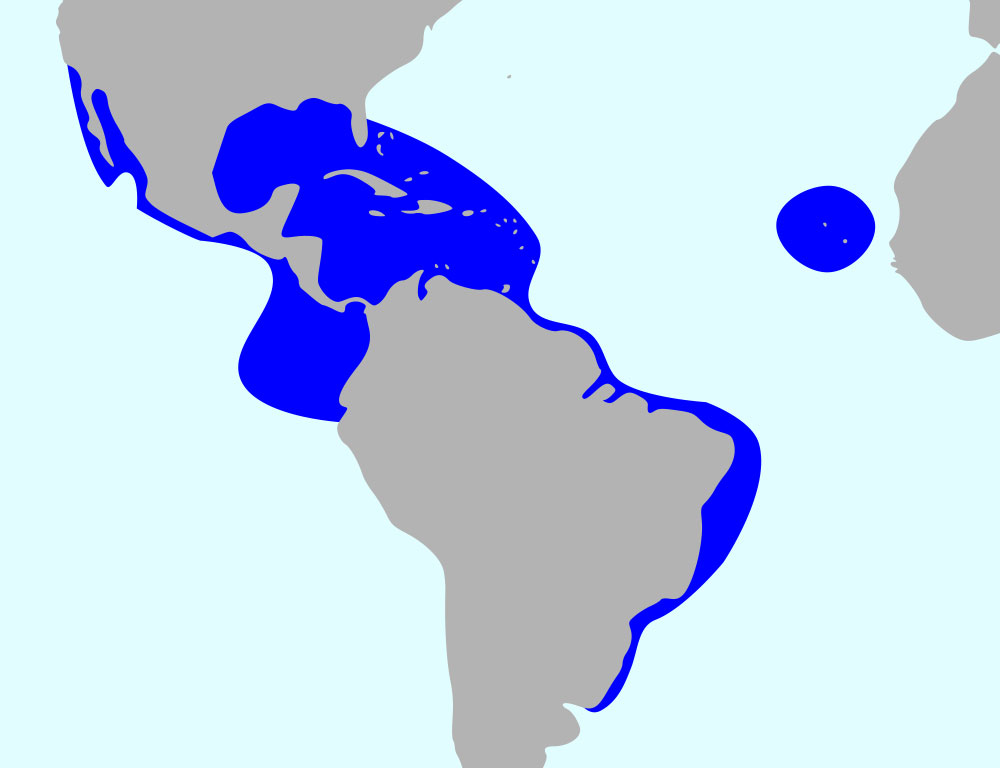
The range of the Magnificent Frigatebird encompasses tropical and subtropical waters worldwide, including the Caribbean, Gulf of Mexico, Pacific and Indian Oceans, and parts of the Atlantic Ocean.
Its distribution is influenced by factors such as food availability and ocean currents.
Nesting
Magnificent Frigatebirds use twigs and other materials to build their nests in trees or bushes near the coast. Breeding pairs engage in elaborate courtship displays, with males inflating their bright red throat pouches to attract females.
The below table is detailing the nesting characteristics of the Magnificent Frigatebird:
| Nesting Details | Facts |
| Clutch Size | Usually 1 egg |
| Number of Broods | Typically 1 per breeding season |
| Egg Length | Approximately 2.5 to 3 inches (6.4 to 7.6 cm) |
| Egg Width | Approximately 1.5 to 2 inches (3.8 to 5.1 cm) |
| Incubation Period | Around 50 days |
| Nestling Period | Roughly 5 months until fledging |
| Egg Description | Whitish with a smooth surface; may have some spotting or mottling |
| Nest Location | They are vulnerable to predation by large birds or mammals, but nesting colonies provide some protection. |
| Nest Construction | Built with twigs and other vegetation |
| Parental Care | Both parents share incubation and feeding duties |
| Nestling Development | They are vulnerable to predation by large birds or mammals, but nesting colonies provide some protection. |
| Nest Predation | Vulnerable to predation by large birds or mammals, but nesting colonies provide some protection |
| Nest Maintenance | Parents may repair or add to the nest throughout the breeding season |
This table provides a comprehensive overview of the nesting habits and characteristics of the Magnificent Frigatebird, offering insight into its reproductive biology and parental care behaviors.
Hunting Habit
These birds are skilled hunters, utilizing their keen eyesight and aerial agility to locate and capture prey. They often soar high in the sky, scanning the water below for signs of fish or other potential prey items.
Diseases and Treatment
Magnificent Frigatebirds may be susceptible to various diseases and parasites, including avian malaria and feather lice.
Conservation efforts may include monitoring populations for signs of disease and providing medical treatment when necessary.
Conservation
While not currently considered globally threatened, Magnificent Frigatebirds face habitat loss, pollution, and human disturbance threats.
Conservation efforts focus on protecting nesting sites, reducing bycatch in fishing gear, and raising awareness about preserving coastal ecosystems.
The life history of the Magnificent Frigatebird is a testament to its adaptability and resilience in the face of environmental challenges.
Understanding and conserving this species and its habitat can ensure its continued survival for future generations to admire and appreciate.
10 Fun Facts About Magnificent Frigatebird
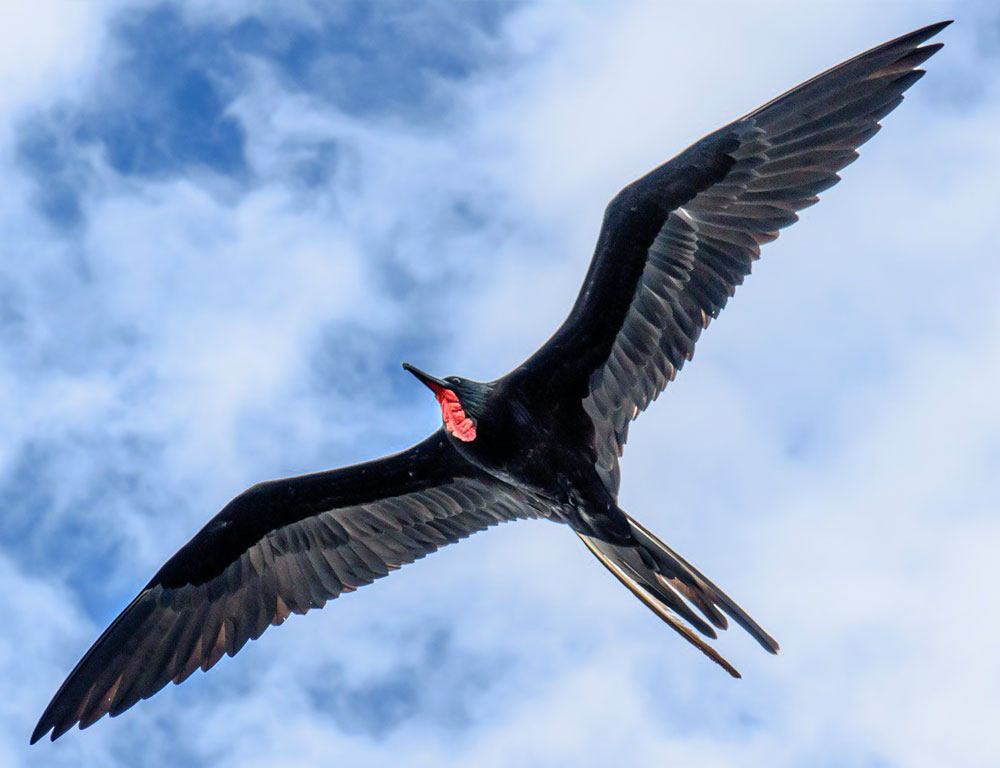
The Magnificent Frigatebird, with its majestic appearance and unique behaviors, captivates the imagination of bird enthusiasts worldwide.
From its impressive aerial displays to its fascinating life history, here are 10 fun facts about this remarkable seabird.
- Longest Wingspan Relative to Body Size: The Magnificent Frigatebird boasts the most extended wingspan-to-body ratio of any bird, enabling it to glide for hours without flapping its wings.
- Males’ Inflatable Throat Pouches: During the breeding season, male Magnificent Frigatebirds inflate their bright red throat pouches to attract females. This display is a striking sight against their black plumage.
- Kleptoparasitism: These birds are notorious for their kleptoparasitic behavior, harassing other seabirds to steal their food mid-air. They are skilled at snatching prey from the beaks of different birds.
- Non-waterproof Plumage: Unlike most seabirds, Magnificent Frigatebirds lack waterproof feathers. This adaptation prevents them from diving into the water to catch prey but aids in their aerial agility.
- Highly Aerial Lifestyle: Magnificent Frigatebirds spend most of their lives in the air, only coming to land to roost, mate, and breed. They are capable of flying hundreds of miles in search of food.
- Colonial Nesters: These birds breed in large colonies, with hundreds to thousands of pairs nesting together. This communal lifestyle protects predators.
- Long Incubation Period: Female Magnificent Frigatebirds have one of the most extended incubation periods among seabirds, lasting around 50 days. Both parents take turns incubating the egg.
- Nomadic Behavior: Outside of the breeding season, Magnificent Frigatebirds are nomadic, following food sources across vast ocean expanses. They may travel thousands of miles in search of prey.
- Fast Growth Rate: Magnificent Frigatebird chicks proliferate, reaching nearly adult size within a few months. They are cared for by both parents until they fledge.
- Conservation Concerns: While not currently considered globally threatened, Magnificent Frigatebirds face habitat loss, pollution, and human disturbance. Conservation efforts are crucial to ensuring their long-term survival.
These fun facts highlight the unique characteristics and behaviors of the Magnificent Frigatebird, making it a truly fascinating species to observe and study in the wild.
Wrapping Up
The Magnificent Frigatebird is a remarkable seabird renowned for its impressive aerial abilities, distinctive appearance, and fascinating behaviors.
From its inflatable throat pouches to its nomadic lifestyle, this species continues to captivate the imagination of bird enthusiasts worldwide.
While facing conservation challenges, the Magnificent Frigatebird symbolizes resilience in the face of environmental threats.
By understanding and appreciating the intricacies of its life history, we can work towards ensuring the preservation of this magnificent species for generations to come.